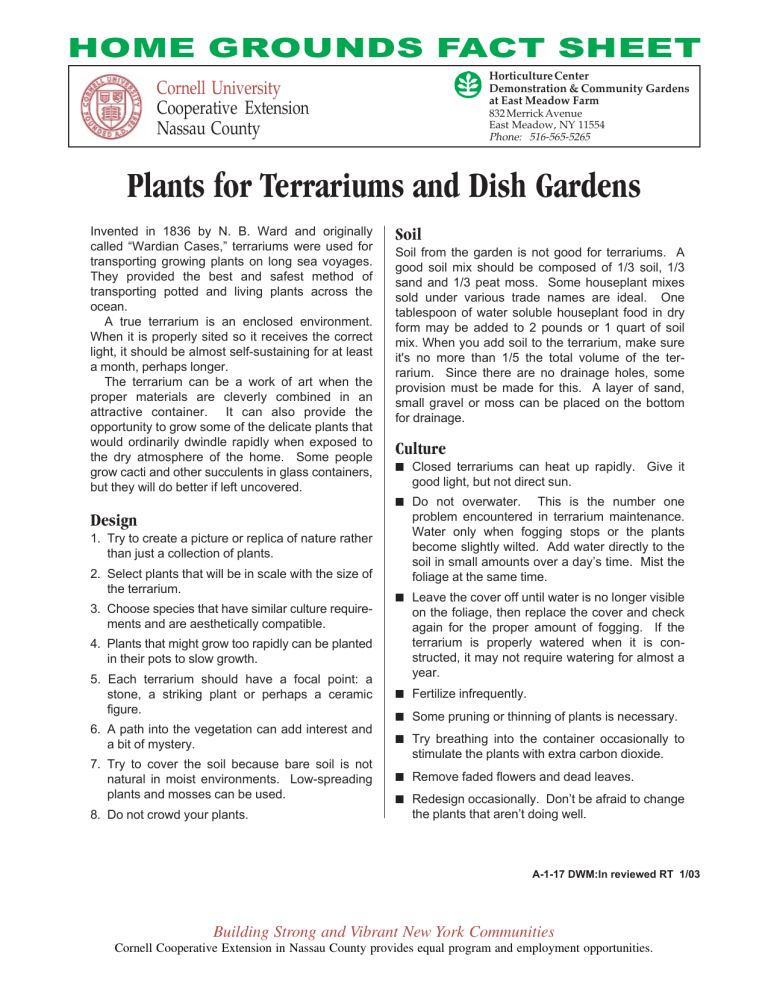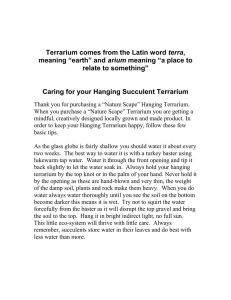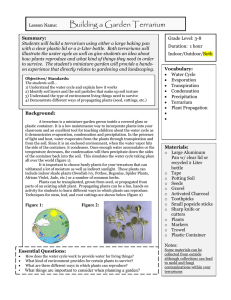
HOME GROUNDS FACT SHEET
Cornell University
Cooperative Extension
Nassau County
Horticulture Center
Demonstration & Community Gardens at East Meadow Farm
832 Merrick Avenue
East Meadow, NY 11554
Phone: 516-565-5265
Plants for Terrariums and Dish Gardens
Invented in 1836 by N. B. Ward and originally called “Wardian Cases,” terrariums were used for transporting growing plants on long sea voyages.
They provided the best and safest method of transporting potted and living plants across the ocean.
A true terrarium is an enclosed environment.
When it is properly sited so it receives the correct light, it should be almost self-sustaining for at least a month, perhaps longer.
The terrarium can be a work of art when the proper materials are cleverly combined in an attractive container. It can also provide the opportunity to grow some of the delicate plants that would ordinarily dwindle rapidly when exposed to the dry atmosphere of the home. Some people grow cacti and other succulents in glass containers, but they will do better if left uncovered.
Design
1. Try to create a picture or replica of nature rather than just a collection of plants.
2. Select plants that will be in scale with the size of the terrarium.
3. Choose species that have similar culture requirements and are aesthetically compatible.
4. Plants that might grow too rapidly can be planted in their pots to slow growth.
5. Each terrarium should have a focal point: a stone, a striking plant or perhaps a ceramic figure.
6. A path into the vegetation can add interest and a bit of mystery.
7. Try to cover the soil because bare soil is not natural in moist environments. Low-spreading plants and mosses can be used.
8. Do not crowd your plants.
Soil
Soil from the garden is not good for terrariums. A good soil mix should be composed of 1/3 soil, 1/3 sand and 1/3 peat moss. Some houseplant mixes sold under various trade names are ideal. One tablespoon of water soluble houseplant food in dry form may be added to 2 pounds or 1 quart of soil mix. When you add soil to the terrarium, make sure it's no more than 1/5 the total volume of the terrarium. Since there are no drainage holes, some provision must be made for this. A layer of sand, small gravel or moss can be placed on the bottom for drainage.
■
■
■
Culture
■ Closed terrariums can heat up rapidly. Give it good light, but not direct sun.
■ Do not overwater. This is the number one problem encountered in terrarium maintenance.
Water only when fogging stops or the plants become slightly wilted. Add water directly to the soil in small amounts over a day’s time. Mist the foliage at the same time.
■ Leave the cover off until water is no longer visible on the foliage, then replace the cover and check again for the proper amount of fogging. If the terrarium is properly watered when it is constructed, it may not require watering for almost a year.
Fertilize infrequently.
Some pruning or thinning of plants is necessary.
Try breathing into the container occasionally to stimulate the plants with extra carbon dioxide.
■
■
Remove faded flowers and dead leaves.
Redesign occasionally. Don’t be afraid to change the plants that aren’t doing well.
A-1-17 DWM:ln reviewed RT 1/03
Building Strong and Vibrant New York Communities
Cornell Cooperative Extension in Nassau County provides equal program and employment opportunities.
PLANTS FOR TERRARIUMS AND DISH GARDENS
The following are three lists of plants for use in the woodland, tropical and desert terrarium.
Woodland plant list
■
■
■
■
■
■
■
■
■
■
Maidenhair Fern - Adiantum pedatum
Mother Spleenwort - Asplenium bulbiferum
Boxwood - Buxus
Dwarf Hinoki Cypress - Chamaecyparis obtusa ‘nana’
Pipsissewa - Chimaphila Umbellata
Wintergreen - Gaultheria procumbens
English Ivy (dwarf forms) - Hedera helix
Liverwort - Hepatica americana
Juniper - Juniperus sp.
Ground Pine - Lycopodium complanatum
■
■
■
■
■
■
■
■
■
Partridgeberry - Mitchella repens
Plectranthus - Plectranthus oertendahli
Shield Spike - Polystichum ‘Braunii’
Club Moss - Selaginella sp.
Dwarf Yew - Taxus media var.
Foam Flower - Tiarella cordifolia
Piggyback Plant - Tolmiea Menziesii
Canadian Hemlock, dwarf varieties -
Tsuga canadensis
Ilex sp. - Ilex (also Holly)
Tropical plant list
■
■
■
■
■
■
■
■
■
■
■
■
■
■
■
■
■
■
■
Friendship plant - Pilea involucrata
Nephthytis (Arrow Leaf Plant) -
Syngonium popdophyllum
Maidenhair Fern - Adiantum pedatum
Norfolk Island Pine - Araucaria heterophylla
Asparagus Fern - Asparagus setaceus
Parlor Palm - Chamaedorea elegans
Kangaroo Vine - Cissus antarctica
Earth Star - Cryptanthus
False Aralia - Dizygotheca elegantissima
Dracaena - Dracaena godseffiana and
Dracaena sanderiana
Creeping Fig - Ficus pumila
Nerve Plant - Fittonia sp.
English Ivy (dwarf forms) - Hedera helix var.
Prayer Plant - Maranta sp.
Miniature Peperomia - Peperomia var.
Philodendron var.
Creeping Jenny - Pilea depressa
Yew Podocarpus - Podocarpus macrophyllus
Table or Brake Ferns - Pteris sp.
■
■
■
■
■
■
■
■
■
■
■
■
■
■
■
■
■
■
African Violet - Saintpaulia
Bird nest Sansevieria - Sansevieria trifasciata
cv.
'Hahnii'
Strawberry Geranium - Saxifraga stolonifera
Pothos - Epipremnum aureum
Spike Moss - Selaginella sp.
Swedish Ivy - Plectranthus australis
Creeping Charlie - Pileanummulari
Wandering Jew - Tripogandra multiflora,
Zebrina pendula , or Tradescantia sp.
Grape ivy - Cissus rhombifolia
Trailing Watermelon Begonia - Pellionia sp.
Aluminum plant - Pilea Cadierei
Baby Tears - Helxine soleiroli
Dwarf Myrtle - Myrtus cummunis microphylla
Artillery fern - Pilea microphylla
Croton - Codiaeum variegatum
Moon Valley Pilea - Pilea ‘Moon Valley
Neanthe Bella Palm - Chamaedorea elegans
‘Neanthe Bella’
Cacti and succulent plant list
■
■
■
■
■
■
■
■
■
■
■
■
■
■
Dwarf Century Plant - Agave pumila
Old Man Cactus - Cephalocereus senilis
Peanut Cactus - Lobivia silvestrii
Cone Plant - Conophytum sp.
Rattail Crassula - Crassula lycopodiodes ‘Maki’
Propeller Plant - Crassula falcata
Rattlesnake Crassula - Crassula teres
Barrel Cactus - Echinocactus Grusonii
Plain Cactus - Gymnocalycium mihanovichii
Window Haworthia - Haworthia cymbiformis
Zebra Haworthia - Haworthia fasciata
Panda Plant - Kalanchoe tomentosa
Living Stones - Lithops sp.
Golden Star Cactus - Mammilaria elongata
■
■
■
■
■
■
■
■
■
■
■
■
■
■
Bunny ears - Opuntia microdasys
Crown Cactus - Rebutia Kupperiana
Coral Beads Plant - Sedum Stahlii
Hen and Chicks - Sempervivum soboliferum
Aeonium arboreum - Aeonium
Bishop’s Cap - Astrophytum sp.
Tom Thumb cactus - Parodia aureispina
Medicinal Aloe - Aloe barbadensis (Aloe vera)
Crested Euphorbia - Euphorbia lactea ‘cristata’
Devil’s Backbone - Pedilanthus tithymaloides
Jade plant - Crassula ovata
Chandelier plant - Kalanchoe tubiflora
Air plant - Kalanchoe pinnata
Ghost plant - Graptopetalum paraguayense
How to Plant a Bottle Garden
3.
Roll larger, leafy plants in paper cylinder to slip them through the neck without damage.
1.
Clean and polish bottle with moist paper towel held in wooden tongs. Dampen towel with window-cleaning spray to remove stains. Let dry before planting.
2.
Add 1" layers of sand and charcoal chips - then a few inches of potting soil using a funnel and paper tube extension to help keep dust down and off sides of bottle.
4.
Use wooden tongs to lower small plants through the neck and to maneuver all plants into position.
5.
A spoon taped to a stick is great for digging planting holes, positioning plants, covering roots and shaping the terrain.
6.
A spool on a stick can be used to tamp and firm soil.
7.
Shaping and pruning can be done with a razor blade taped to a stick.
Pick up prunings with tongs.
8.
Use a bulb syringe to wash sides of glass, water roots into place and settle soil. Use it dry to blow dust and soil particles off glass or leaves.
A-1-17 DWM:ln reviewed RT 1/03



